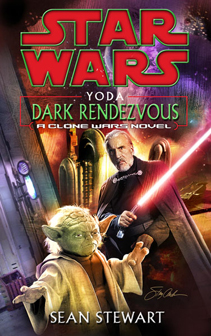Throughout the entire George Lucas “Star Wars” reign, we never got Yoda’s backstory, partly because it was declared off limits and partly because few authors would be brave enough to tackle such a responsibility. However, the final arc of “The Clone Wars” gave us a fascinating Yoda arc – where he fights his Gollum-esque dark side avatar and communicates with the deceased Qui-Gon. And one novel gave us a cool portrait of the old Jedi Master: 2004’s “Yoda: Dark Rendezvous.”
Despite the title, Yoda isn’t the point-of-view character of Sean Stewart’s lone “Star Wars” novel, nor is he even the main character. Rather, Yoda plays the same role he always does: Dispensing advice to young Padawans (Scout and Whie) and even a fallen former student (Count Dooku). It’s just that he’s more prominently featured than usual, and Stewart understands Yoda’s comedic nature – something that is front and center when we first met him in “The Empire Strikes Back,” and then again in the classroom scene of “Attack of the Clones” — more than most authors.
I love the other Jedis’ reactions to the disgusting meals that Yoda finds appetizing – including one where a tail is sticking out of the side of his soup bowl – and Stewart’s physical descriptions of a character who many fans find lovable but who is, arguably, ugly. For example, Yoda suggests that he should go undercover as a child:
His old face crinkled into a hideously unconvincing childish smirk. The others involuntarily recoiled.
And later, Yoda shows up on the window ledge at Dooku’s palace:
Rain was running down the furrows of his wrinkled face, and he was grinning like a gargoyle.
While Whie flirting with the dark side, and Yoda talking him out of it, is a standard theme in “Star Wars” novels, Stewart delivers some beautiful writing on the topic through Yoda’s dialogue:
“There you see: darkness, darkness everywhere, and a few stars. A few points of light. If no plan there is, no fate, no destiny, no providence, no Force: then what is left? Nothing but our choices, hmm?”
Later, Stewart stages a gripping psychological war of words where Yoda asks Dooku to convince him to turn to the dark side. Dooku lists various dark side perks, but Yoda is of course not interested in the trait that binds these perks together: control over other people. Yoda tells Dooku he’ll turn to the dark side if he can produce a rose out of thin air. Dooku can’t, as the dark side does not have the power to create something out of nothing. (Interestingly, I bet Dathomir’s Mother Talzin could’ve created a rose out of seemingly nothing. A debate between Talzin and Yoda would be interesting.)
“Dark Rendezvous” feels like Stewart’s stab at telling a definitive bridging novel between Episodes II and III, even improving on aspects of “Attack of the Clones” – deepening the relationship between Yoda and Dooku and illustrating the specifics of what makes Yoda and (most of) the Jedi right and moral. Other big moments include Obi-Wan and Anakin discussing Anakin’s feelings for Padme, and Asajj Ventress requesting to formally become Dooku’s apprentice, but being rebuffed.
The plotting in the middle segment of the book is a bit rough. It doesn’t seem likely to me that Yoda would have to go undercover just for the sake of the media not knowing that he’s off on a mission. And I don’t know if it’s in Ventress’ character to go off half-cocked and attempt to kill Yoda, rather than obeying Dooku. In most portrayals, Ventress is desperately loyal to Dooku right up until the point that he kicks her to the curb (in the continuities of the “Republic” comics and “The Clone Wars” TV series — or both if you can somehow reconcile the two).
Mostly, though, Stewart does an admirable job of grasping the GFFA and tying “Dark Rendezvous” into the wider mythos. On multiple occasions, he references the destruction of Honoghr from “Dark Force Rising,” and ties General Grievous to the event. Stewart also notes that Anakin thought he killed Dooku on a previous mission, but it was a doppleganger – this is a reference to “The New Droid Army,” a 2002 Gameboy Advance Game.
I also really like the young teenage Padawans Whie and Scout, who cutely have crushes on each other, but as is the case far too often in “Star Wars” novels, the thread dies here. At least the two characters – albeit separately – do appear in other stories. Whie is among the young Padawans who are murdered by Anakin in “Revenge of the Sith,” while Scout pops up in the last two books of Karen Traviss’ “Republic/Imperial Commando” series.
The main reason to check out “Dark Rendezvous,” though, is that it’s as close to a definitive Yoda novel as we have gotten so far.


